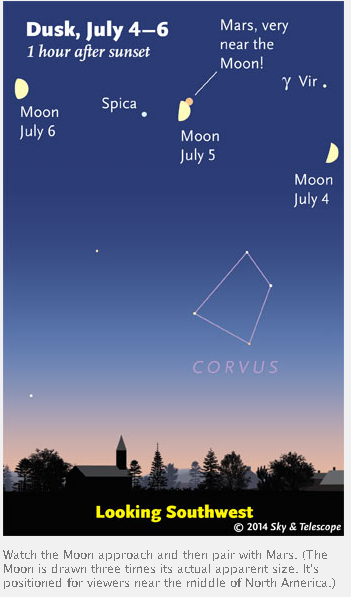A rare celestial configuration of Moon, Mars, and Spica
I mentioned this coming up on Twitter in both of my active accounts, in the business one, that I have been using for nearly 7 years now, and in my personal one. As an astronomy buff, I live for events like that. Totally inexpensive, no equipment needed, and you can enjoy them even in a big city like the City of Angels, where I happen to reside and have for 15 years now. Yes, time flies fast. I have never lived in any other city for that long.
Moon very close to Mars (occults it in Hawaii), close to Spica (the brightest star in Virgo) tonight, July 5th - http://t.co/DVk3ymYXQB
— Waldemar Puszkarz (@psi_bar) July 5, 2014Even though LA may not seem to the best place for astronomical observations, it can actually be one of the best places on the Earth for them when it comes to bright celestial objects, such as the Moon, the planets, or bright stars. That, obviously, has to do with the great weather that Southern California is so well-known for: dry and sunny, which often gives rise to clear skies. It's one of the best weather types you can find on this planet, one of the best in the US, and one of the factors that make Southern California such a great place to live, and so crowded as a result: the LA county, the most populous county in the US, is as populous as many a European country, with about 10 million people living here.
The Moon, the planets and the stars form some pretty configurations from time to time when they come close together, in what is called conjunctions in scientific parlance. Such was the case this time around, on July 5th, 2014, when the Moon came very close to Mars and Spica, the latter being the brightest star in the Virgo (the Maiden) constellation. The Moon came so close to Mars that it even occulted it, but you could only observe it in Hawaii or Central America, not from the continental US.
You could see all three objects aligned pretty much in straight line quite high over the Southern horizon, with Mars the highest of them all and Spica the lowest. It's quite amazing how high Spica can be on the sky in LA compared to Poland, which has to do with LA being about 15 degrees to the South in lattitude compared to the southernmost parts of Poland.
Mars was not the only planet to be seen that night. Saturn was also in that part of the sky, over the Southern horizon, to the east of the other three objects, and to the south, which means lower. And Spica wasn't the only bright star over the Southern horizon either. You could also see two other bright stars there: one red and one orange. The former was Antares (below and to the east off Saturn) and the latter was Arcturus, very much above the main three actors, perched quite high above them. All these stars are at least the first magnitude stars, easy to notice even in well-lit places such as Los Angeles.
The picture below, taken from Sky&Telescope, (see the original here), may give you some idea of what things looked like that night, though not exactly, and it does not show the other stars I mentioned nor Saturn.

Posted on July 6th, 2014.